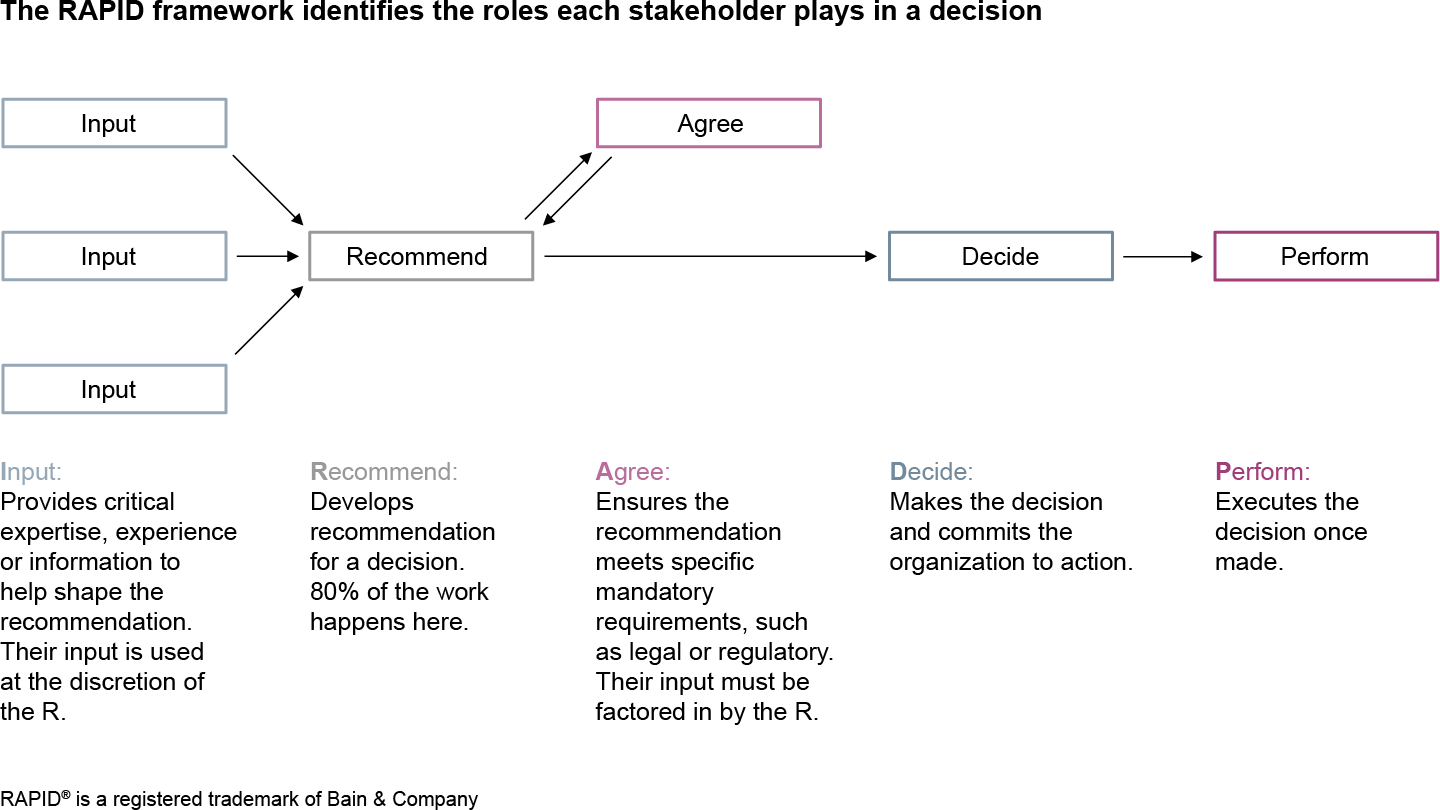Article
What is RAPID decision making?
RAPID is a proprietary decision-making tool created by Bain & Company to clarify decision accountabilities with multiple stakeholders. It is part of a disciplined approach that defines the “what, who, how, and when” of decision making and can lead to improved decision effectiveness. Effective decision making is closely linked to strong organizational performance. Successful companies consistently make high-quality decisions at the right pace and execute them well.
What does RAPID stand for?
The acronym RAPID stands for the five essential roles involved in the decision-making process: Recommend, Agree, Perform, Input, and Decide.
How is RAPID used in decision making?
The RAPID decision-making model provides transparency on decision accountabilities, reduces ambiguity, and streamlines the decision-making process. It establishes a common language and leaves no doubt about who is on point for each role. When teams and organizations use RAPID correctly, they execute strategy at pace. Not every decision requires the level of effort and investment that goes into creating explicit RAPID roles. Successful adopters start by applying RAPID to high-value or high-frequency decisions. They create positive and visible impact on priority decisions while enhancing decision-making skills across the organization. Over time, the RAPID framework becomes intuitive and easy to use wherever decision-making roles are not clear.
What are the five RAPID decision-making roles?
The recommend (R) role drives the process, gathering relevant input and developing a recommendation for the decider. The recommend role has broad visibility and access to information, and initially aligns with the decider on the decision’s strategic context, timing, criteria, and required inputs. Only one recommender is assigned for each decision. This role must have both the decider’s trust and credibility with all the other RAPID roles. Recommenders must be capable of directing and engaging stakeholders in a timely way to ensure the decision moves quickly and efficiently.
The agree (A) role must agree that the final recommendation is feasible to bring forward to the decision maker; their input must be reflected in the proposal. Agree roles are assigned sparingly and may not be needed for all decisions. The agree role ensures the recommendation meets specific mandatory requirements, such as legal or regulatory requirements, and provides their input to the recommender. The agreer collaborates with the recommender early on to develop a viable recommendation. If the recommend role and the agree role cannot reconcile their views, the decide role will make the final call.
The perform (P) role identifies those accountable for implementing the decision once it is made. They understand the intent and context of the decision and are on point to deliver. Companies need to assign a perform role promptly once a decision is made to ensure a timely transition to the execution phase. Whenever possible, organizations should define perform roles early and may also assign them an input role. Performers can flag implementation issues to factor into the decision and are more likely to buy into the final decision and accelerate execution planning.
The input (I) role provides expertise, experience, or information that shapes the recommendation. The input role should also include those who will be affected by the decision or involved in execution so they can bring visibility to risks and downstream implications. Those in the input role must feel included, respected, and empowered in a decision-making process, even if their input is not ultimately reflected in the outcome of the decision. The input role is a big responsibility and can have substantial influence on the quality of a decision through timely and credible contributions.
The decide (D) role makes the final decision and commits the organization to action. Ideally, there should only be one decider for each decision. If the decide role must be held by a group, there should be clarity up front on how they will reach a final decision if there’s not agreement. For example, will it be by majority vote, or does the chair have the final say? The decide role has a broad view of the decision’s trade-offs, has primary accountability for the outcome, and sits as close to where the decision will be implemented as possible. The decider aligns with the recommender up front on the right process, communicates the decision and rationale to stakeholders, and ensures the decision has the appropriate resources for strong execution.

